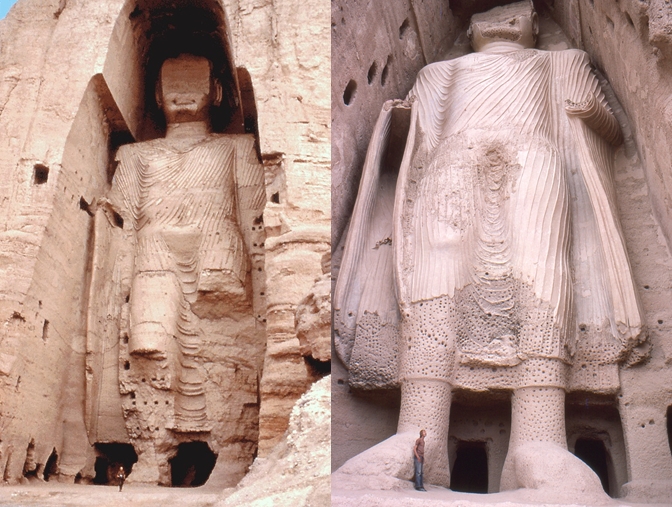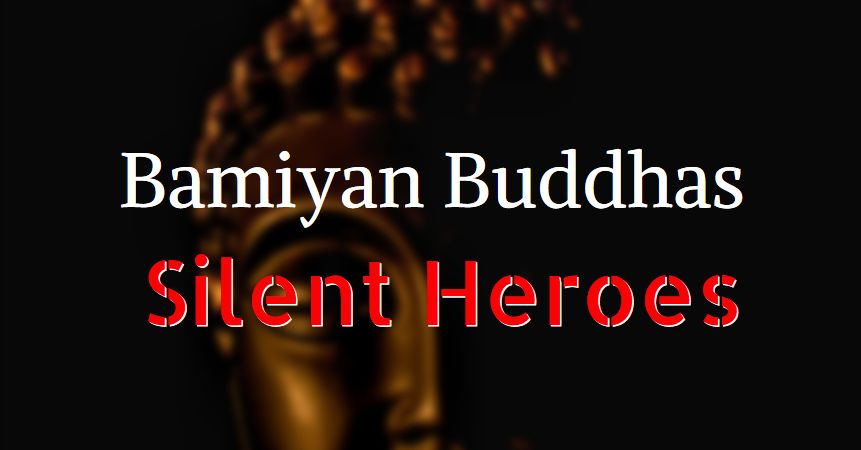The Bamiyan Buddhas stood for nearly two millennia as silent heroes, symbols of the Buddhist faith, witnesses to the hustle and the bustle of the Silk Route with its whirlwind of wealth, ideological exchange, and art, and to countless illogical wars.
In silence they stood since the middle of the first century, and witnessed. Did they know they were the largest in the world? Perhaps they heard rumors. Did they even care? I think not. Like the Buddhism they stood for, they enjoyed the freedom to observe and meditate, learning about human nature and that nothing lasts forever.

But how did the Bamiyan Buddhas really look like?
Yes, like standing Buddhas carved into performing specific gestures, but also carved into niches, allowing worshipers to circulate all around their feet, at the base of the statue, while meditating. They were not just shaped into the face of the mountain. By hairstyle they were Buddhist, but their capes showed clear Hellenistic Greek influences (think Louvre’s Winged Victory of Samothrace) as well as Indian elements. Two cosmopolitan masterpieces.
The tallest Buddha was almost as tall as the first floor of the Eiffel Tower, Paris, or half the height of the Victoria Tower, London, or almost a third of the height at which World Trade Center once stood.
If we would have a telescope to look back in time we would see:
‘a rock statue of the Buddha standing, one hundred forty or fifty feet in height, a dazzling golden color and adorned with brilliant gems.’
as well as
‘a copper statue of the Buddha standing, more than one hundred feet tall.’
The Great Tang Records of the Western Regions (Da Tang Xiyu Ji) by Xuanzang (Hsuan-Tsang), chinese monk, description written in 643

What happened to the Bamiyan Buddhas, these Silent Heroes?
‘Taliban forces operating in Afghanistan had destroyed these colossal statues in March 2001. They started by damaging the Buddha with anti-aircraft firearms and cannons. Yet the damage inflicted was not enough for the Taliban. They returned with anti-tank mines that they placed at the statues’ bases. When sections of rock broke off, the statues suffered further damage. And still, they did not stop here. The Taliban dropped men down the face of the cliff. They had placed explosives into the various grooves found in the Buddhas. The plan was clear, to completely destroy the facial features of the two statues. Maybe a bad understanding of the Quran: Islam condemns idolatry. When one of the blasts could not destroy the facial features of one statue, a rocket was used in its place. It left a hideous gap in whatever was left of the Buddha’s head.
The Taliban did not succeed in wiping out the two Buddhas, but they became unrecognizable as the figures they once were. A cultural, religious, historical and entomological symbol and landmark.
It was a bleak day in human history when something that watched over the valley for 1 500 years was destroyed in a matter of weeks.
Thanks to 21st-century technology the larger of the two Buddhas has been reconstructed using 3D light projections. A holographic image which, unfortunately, is only unveiled rarely, during special occasions.’
Silent Heroes by Patricia Furstenberg
Why destroy the Bamiyan Buddhas?
Maybe a bad understanding of the Quran, as Islam condemns idolatry and Taliban was known for their extreme iconoclastic campaigns. Maybe a need for gaining global media attention. Or just pure evil.
Bamiyan is now listed by UNESCO as a World Heritage Site in Danger.


